belt TOYOTA TACOMA 2011 Owners Manual (in English)
[x] Cancel search | Manufacturer: TOYOTA, Model Year: 2011, Model line: TACOMA, Model: TOYOTA TACOMA 2011Pages: 548, PDF Size: 9.86 MB
Page 1 of 548
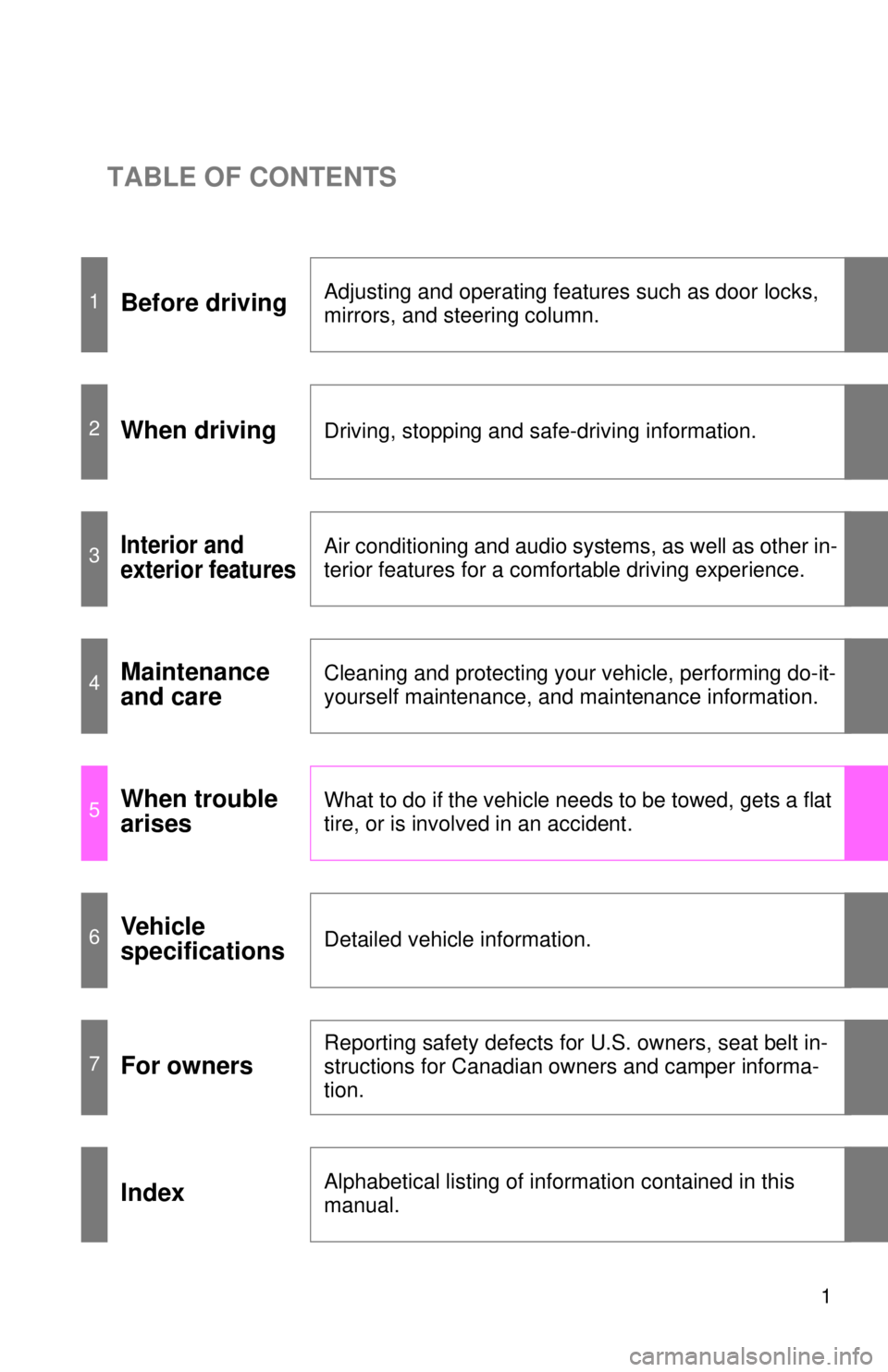
TABLE OF CONTENTS
1
1Before drivingAdjusting and operating features such as door locks,
mirrors, and steering column.
2When drivingDriving, stopping and safe-driving information.
3Interior and
exterior featuresAir conditioning and audio systems, as well as other in-
terior features for a comfortable driving experience.
4Maintenance
and careCleaning and protecting your vehicle, performing do-it-
yourself maintenance, and maintenance information.
5When trouble
arisesWhat to do if the vehicle needs to be towed, gets a flat
tire, or is involved in an accident.
6Vehicle
specificationsDetailed vehicle information.
7For owners
Reporting safety defects for U.S. owners, seat belt in-
structions for Canadian owners and camper informa-
tion.
IndexAlphabetical listing of information contained in this
manual.
Page 2 of 548
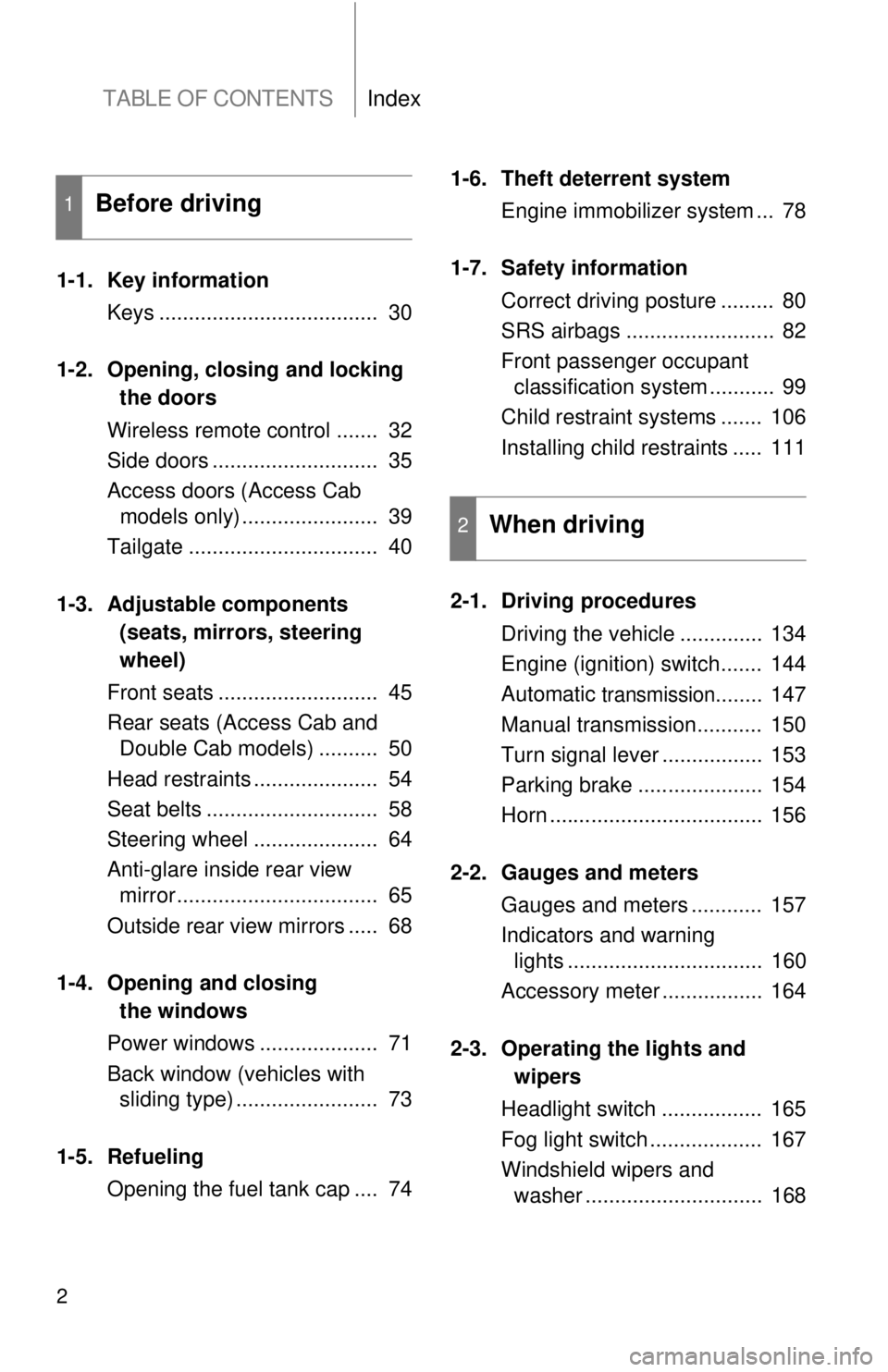
TABLE OF CONTENTSIndex
2
1-1. Key informationKeys ..................................... 30
1-2. Opening, closing and locking
the doors
Wireless remote control ....... 32
Side doors ............................ 35
Access doors (Access Cab models only) ....................... 39
Tailgate ................................ 40
1-3. Adjustable components
(seats, mirrors, steering
wheel)
Front seats ........................... 45
Rear seats (Access Cab and Double Cab models) .......... 50
Head restraints ..................... 54
Seat belts ............................. 58
Steering wheel ..................... 64
Anti-glare inside rear view mirror .................................. 65
Outside rear view mirrors ..... 68
1-4. Opening and clos ing
the windows
Pow er windows .................... 71
Back window (vehicles with sliding type) ........................ 73
1-5. Refueling Opening the fuel tank cap .... 74 1-6. Theft deterrent system
Engine immobilizer system ... 78
1-7. Safety information Correct driving posture ......... 80
SRS airbags ......................... 82
Front passenger occupant classification system ........... 99
Child restraint systems ....... 106
Installing child restraints ..... 111
2-1. Driving procedures Driving the vehicle .............. 134
Engine (ignition) switch....... 144
Automatic
transmission........ 147
Manual transmission........... 150
Turn signal lever ................. 153
Parking brake ..................... 154
Horn .................................... 156
2-2. Gauges and meters Gauges and meters ............ 157
Indicators and warning lights ................................. 160
Accessory meter ................. 164
2-3. Operating the li ghts and
wipers
Headlight switch ................. 165
Fog light switch ................... 167
Windshield wipers and washer .............................. 168
1Before driving
2When driving
Page 5 of 548

1
2
3
4
5
6
7
5
5-1. Essential informationEmergency flashers ............ 430
If your vehicle needs to be towed ........................... 431
If you think something is wrong ............................ 437
Fuel pump shut off system .............................. 438
Event data recorder ............ 439
5-2. Steps to take in an emergency If a warning light turns on or a warning buzzer
sounds... ........................... 441
If you have a flat tire............ 450
If the engine will not start .... 468
If the shift lever cannot be shifted from P.................... 469
If you lose your keys ........... 470
If the vehicle battery is discharged ........................ 471
If your vehicle overheats ..... 475
If the vehicle becomes stuck ................................. 478
If your vehicle has to be stopped in
an emergency ................... 480 6-1. Specifications
Maintenance data (fuel, oil level, etc.) ........... 484
Fuel information.................. 504
Tire information .................. 507
6-2. Customization Customizable features........ 518
Items to initialize ................. 519
Reporting safety defects for U.S. owners ................ 522
Seat belt instructions for Canadian owners
(in French) ........................ 523
Camper information ............ 525
Abbreviation list ........................ 532
Alphabetical index .................... 534
What to do if... ........................... 544
5When trouble arises6Vehicle specifications
7For owners
Index
Page 12 of 548
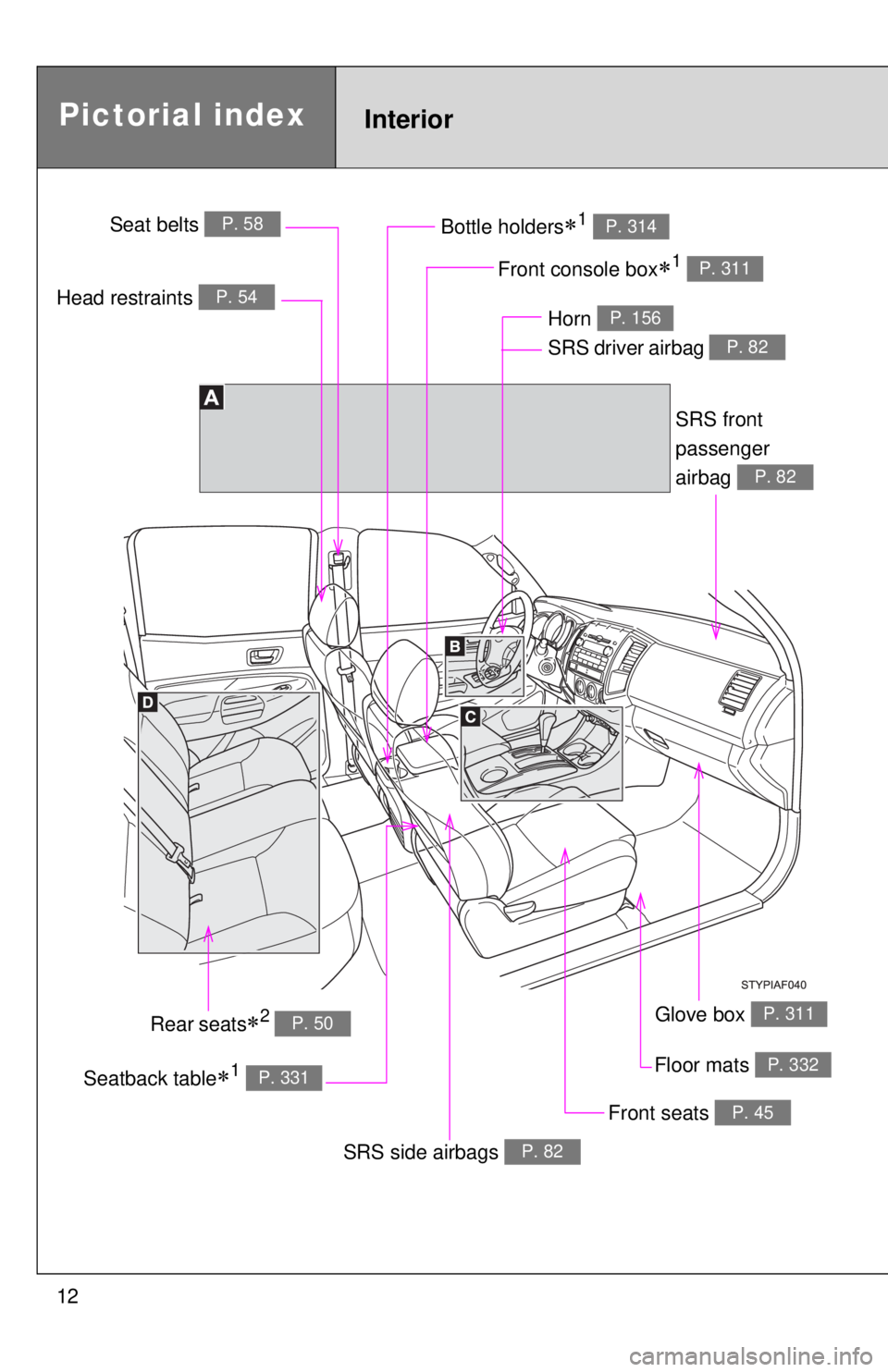
12
Pictorial indexInterior
Seat belts P. 58
Head restraints P. 54
Bottle holders1 P. 314
Seatback table1 P. 331
SRS side airbags P. 82
Floor mats P. 332
SRS front
passenger
airbag
P. 82
Rear seats2 P. 50
Front seats P. 45
Glove box P. 311
Front console box1 P. 311
Horn
SRS driver airbag P. 156
P. 82
Page 25 of 548

25
Installation of a mobile two-way radio system
As the installation of a mobile two-way radio system in your vehicle could
affect electronic systems such as the multiport fuel injection system/sequen-
tial multiport fuel injection system, cruise control system, anti-lock brake sys-
tem, SRS airbag system and seat belt pretensioner system, be sure to check
with your Toyota dealer for precautionary measures or special instructions
regarding installation.
Scrapping your Toyota
The SRS airbag and seat belt pretensioner devices in your Toyota contain
explosive chemicals. If the vehicle is scrapped with the airbags and seat belt
pretensioners left as they are, this may cause an accident such as fire. Be
sure to have the systems of the SRS airbag and seat belt pretensioner
removed and disposed of by a qualified service shop or by your Toyota
dealer before you scrap your vehicle.
Perchlorate Material
Special handling may apply,
See www.dtsc.ca.gov/hazardouswaste/perchlorate.
Your vehicle has components that may contain perchlorate. These compo-
nents may include airbag, seat belt pretensioners, and wireless remote con-
trol batteries.
Page 29 of 548
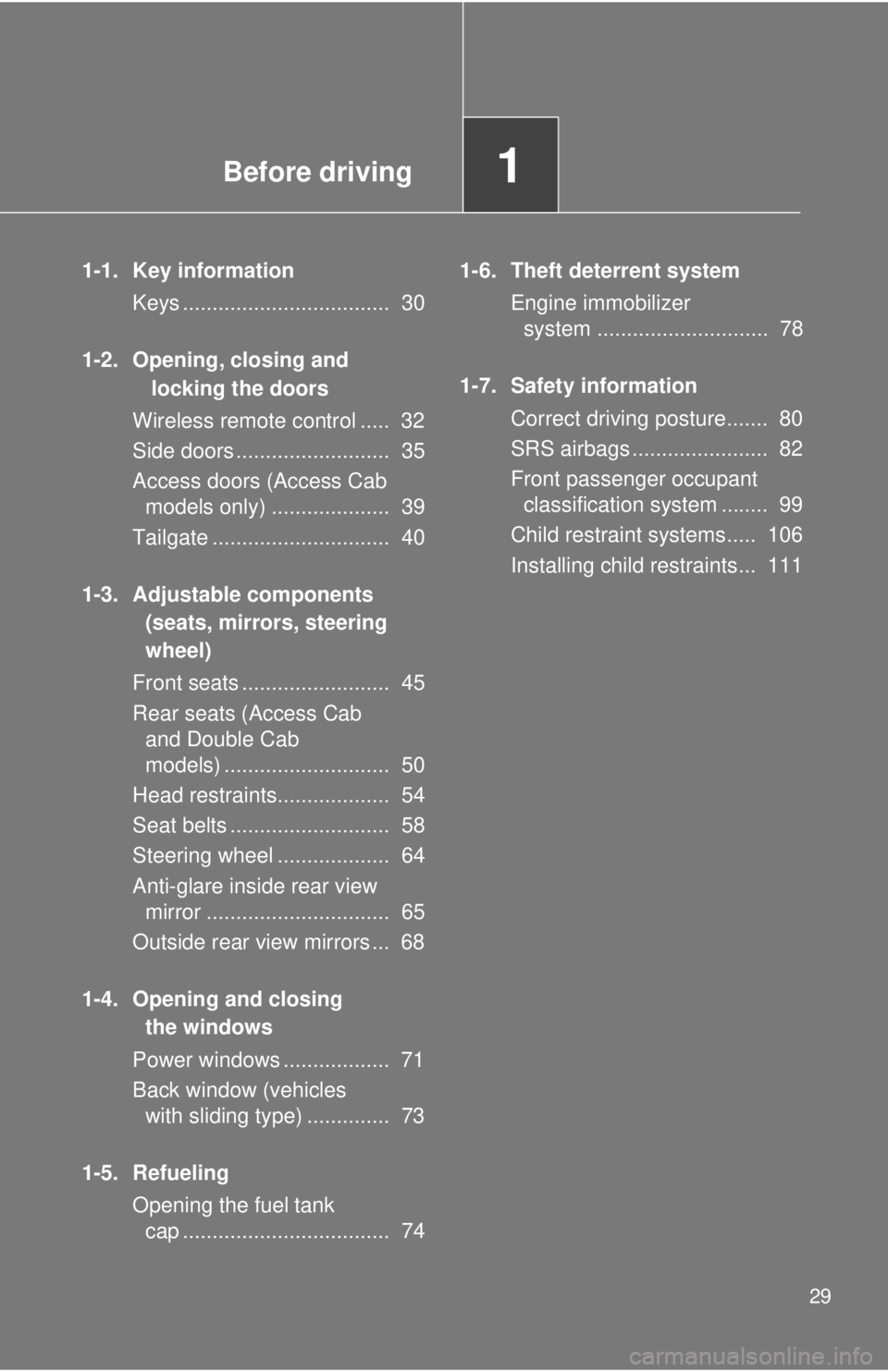
Before driving1
29
1-1. Key informationKeys ................................... 30
1-2. Opening, closing and locking the doors
Wireless remote control ..... 32
Side doors .......................... 35
Access doors (Access Cab models only) .................... 39
Tailgate .............................. 40
1-3. Adjustable components (seats, mirrors, steering
wheel)
Front seats ......................... 45
Rear seats (Access Cab and Double Cab
models) ............................ 50
Head restraints................... 54
Seat belts ........................... 58
Steering wheel ................... 64
Anti-glare inside rear view mirror ............................... 65
Outside rear view mirrors ... 68
1-4. Opening and closing the windows
Power windows .................. 71
Back window (vehicles with sliding type) .............. 73
1-5. Refueling Opening the fuel tank cap ................................... 74 1-6. Theft deterrent system
Engine immobilizer system ............................. 78
1-7. Safety information Correct driving posture....... 80
SRS airbags ....................... 82
Front passenger occupant classification system ........ 99
Child restraint systems..... 106
Installing child restraints... 111
Page 38 of 548
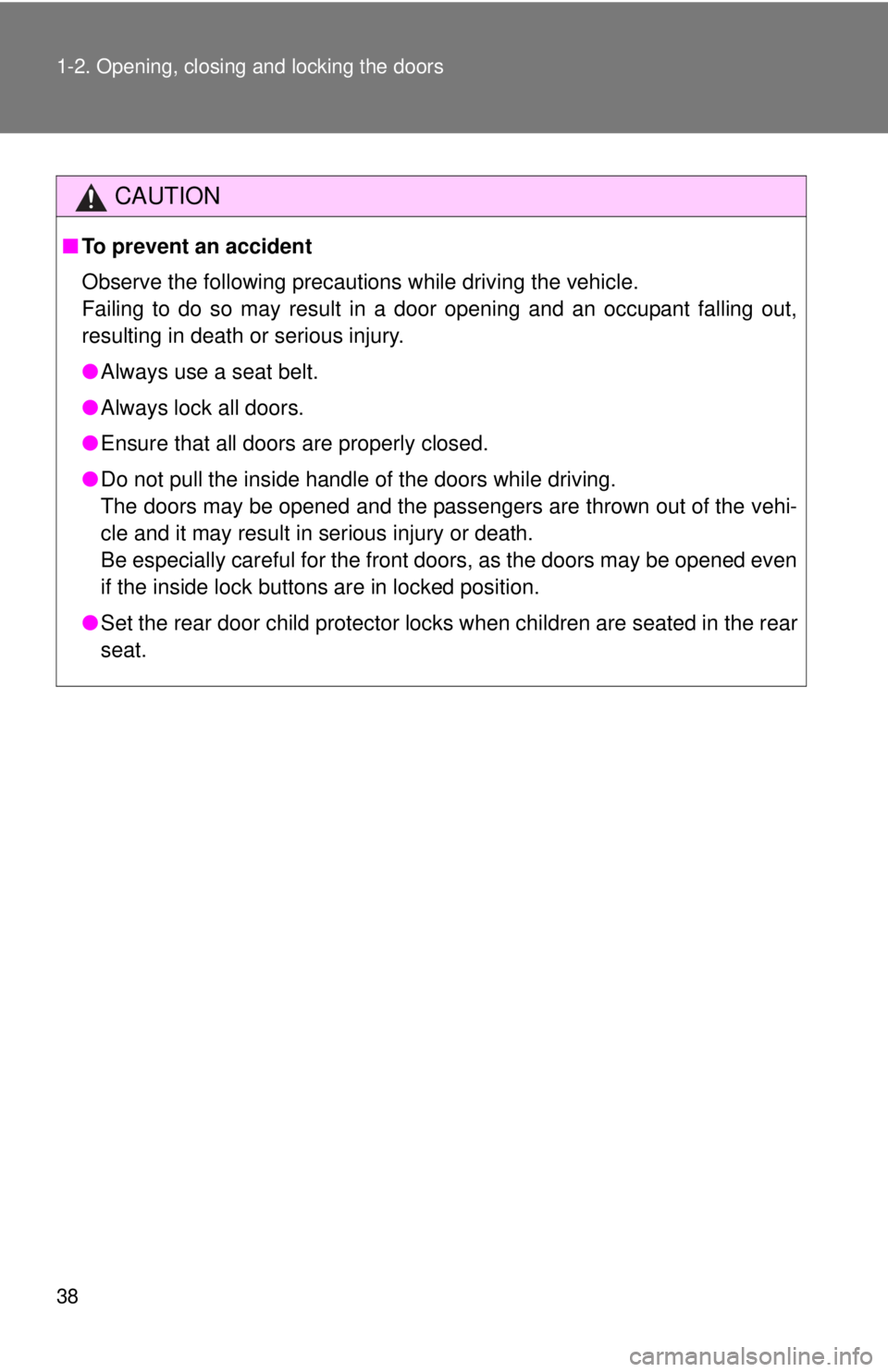
38 1-2. Opening, closing and locking the doors
CAUTION
■To prevent an accident
Observe the following precautions while driving the vehicle.
Failing to do so may result in a door opening and an occupant falling out,
resulting in death or serious injury.
●Always use a seat belt.
● Always lock all doors.
● Ensure that all doors are properly closed.
● Do not pull the inside handle of the doors while driving.
The doors may be opened and the passengers are thrown out of the vehi-
cle and it may result in serious injury or death.
Be especially careful for the front doors, as the doors may be opened even
if the inside lock buttons are in locked position.
● Set the rear door child protector locks when children are seated in the rear
seat.
Page 49 of 548
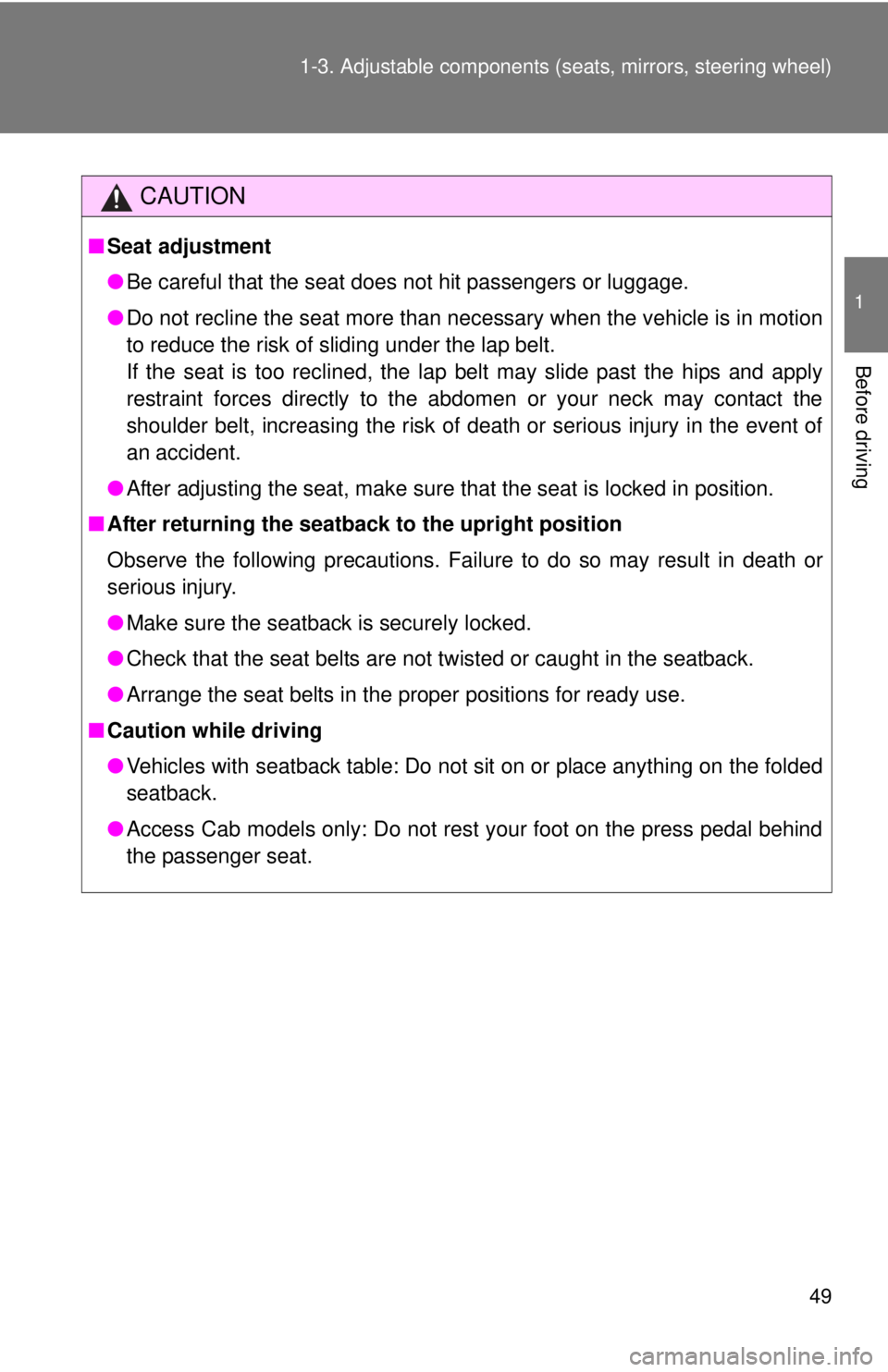
49
1-3. Adjustable components (s
eats, mirrors, steering wheel)
1
Before driving
CAUTION
■Seat adjustment
●Be careful that the seat does not hit passengers or luggage.
● Do not recline the seat more than necessary when the vehicle is in motion
to reduce the risk of sliding under the lap belt.
If the seat is too reclined, the lap belt may slide past the hips and apply
restraint forces directly to the abdomen or your neck may contact the
shoulder belt, increasing the risk of death or serious injury in the event of
an accident.
● After adjusting the seat, make sure that the seat is locked in position.
■ After returning the seatback to the upright position
Observe the following precautions. Failure to do so may result in death or
serious injury.
●Make sure the seatback is securely locked.
● Check that the seat belts are not twisted or caught in the seatback.
● Arrange the seat belts in the proper positions for ready use.
■ Caution while driving
●Vehicles with seatback table: Do not sit on or place anything on the folded
seatback.
● Access Cab models only: Do not rest your foot on the press pedal behind
the passenger seat.
Page 50 of 548
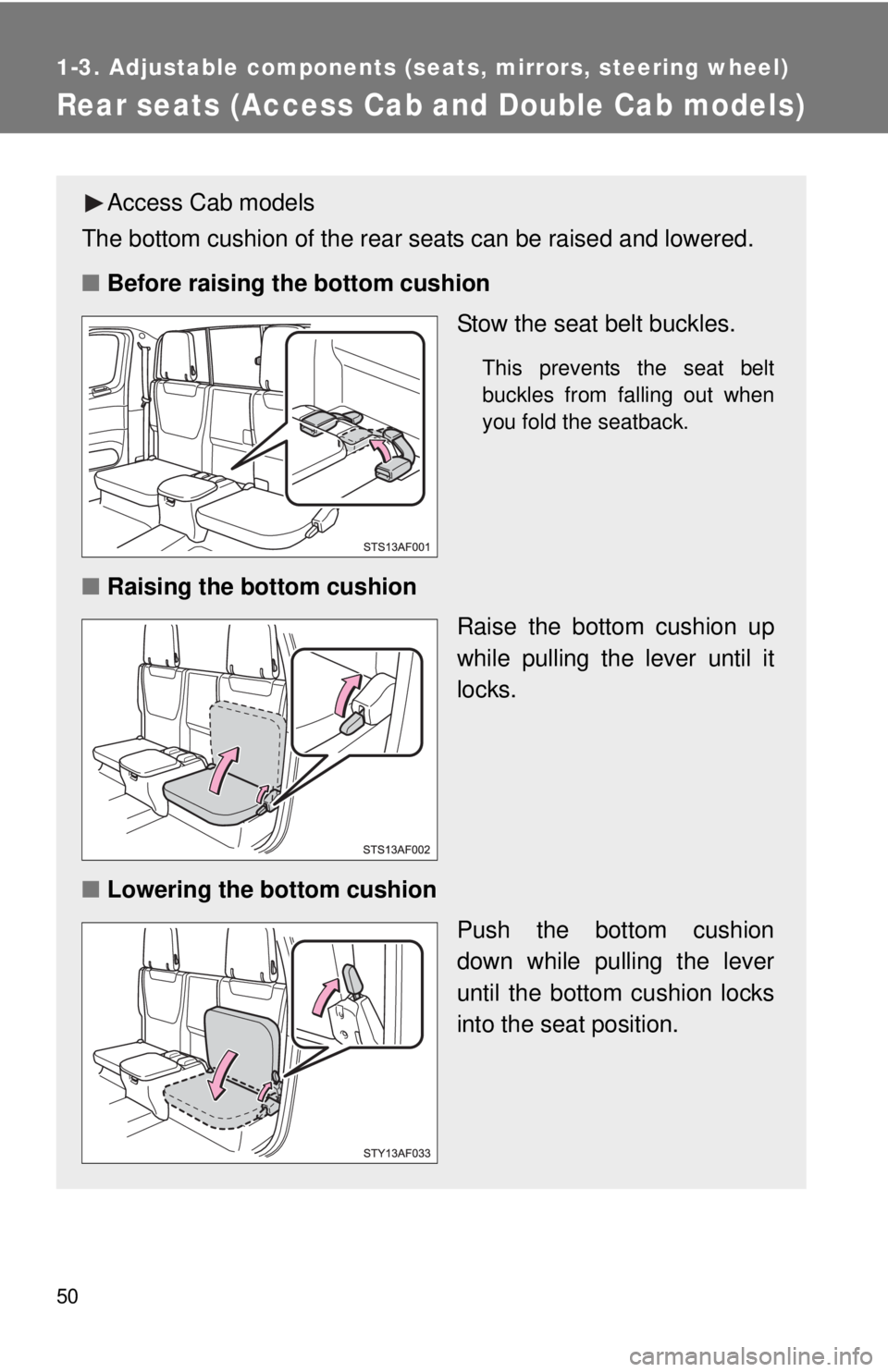
50
1-3. Adjustable components (seats, mirrors, steering wheel)
Rear seats (Access Cab and Double Cab models)
Access Cab models
The bottom cushion of the rear seats can be raised and lowered.
■ Before raising the bottom cushion
Stow the seat belt buckles.
This prevents the seat belt
buckles from falling out when
you fold the seatback.
■Raising the bottom cushion
Raise the bottom cushion up
while pulling the lever until it
locks.
■ Lowering the bottom cushion
Push the bottom cushion
down while pulling the lever
until the bottom cushion locks
into the seat position.
Page 51 of 548
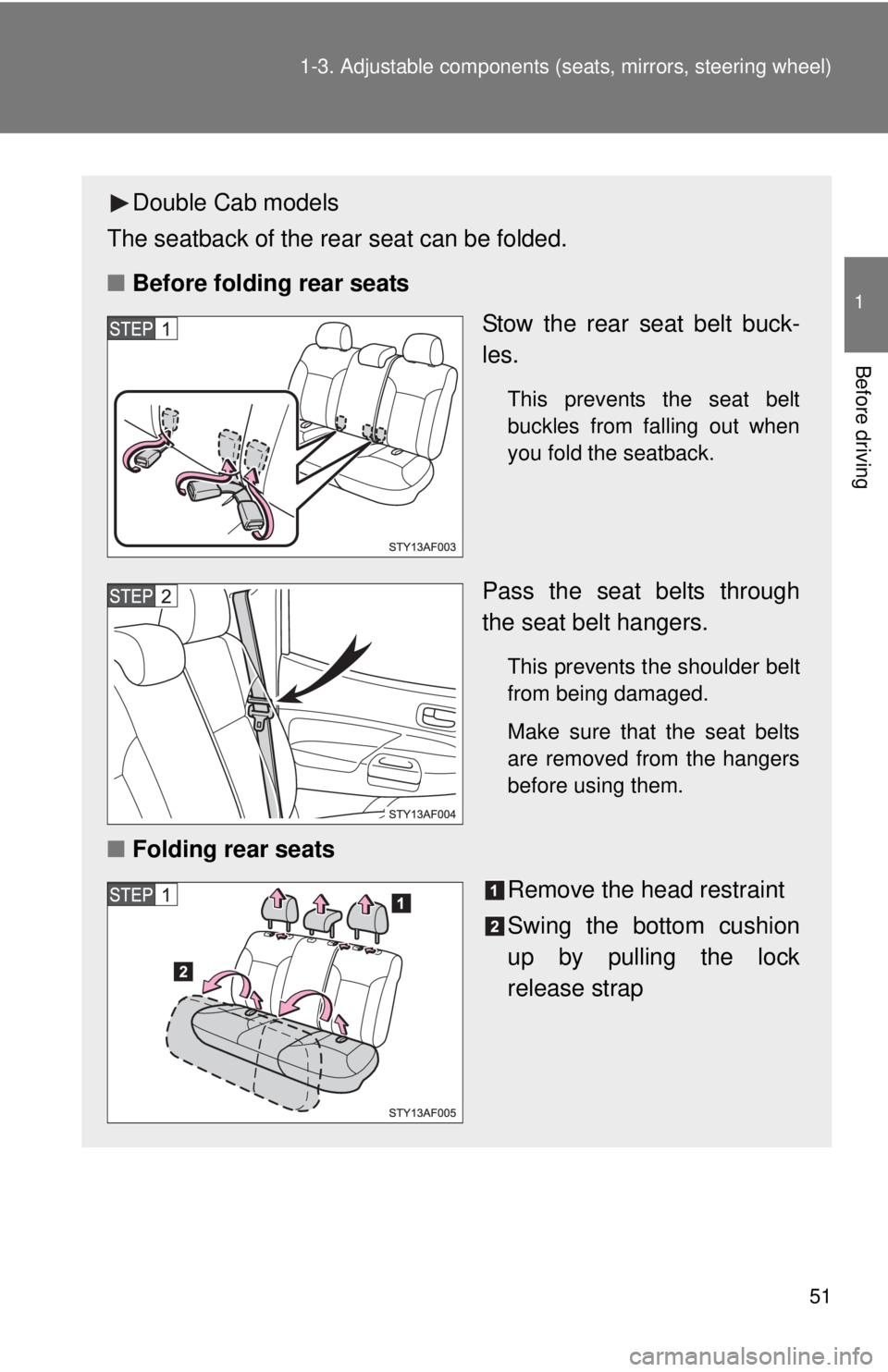
51
1-3. Adjustable components (s
eats, mirrors, steering wheel)
1
Before driving
Double Cab models
The seatback of the rear seat can be folded.
■ Before folding rear seats
Stow the rear seat belt buck-
les.
This prevents the seat belt
buckles from falling out when
you fold the seatback.
Pass the seat belts through
the seat belt hangers.
This prevents the shoulder belt
from being damaged.
Make sure that the seat belts
are removed from the hangers
before using them.
■Folding rear seats
Remove the head restraint
Swing the bottom cushion
up by pulling the lock
release strap